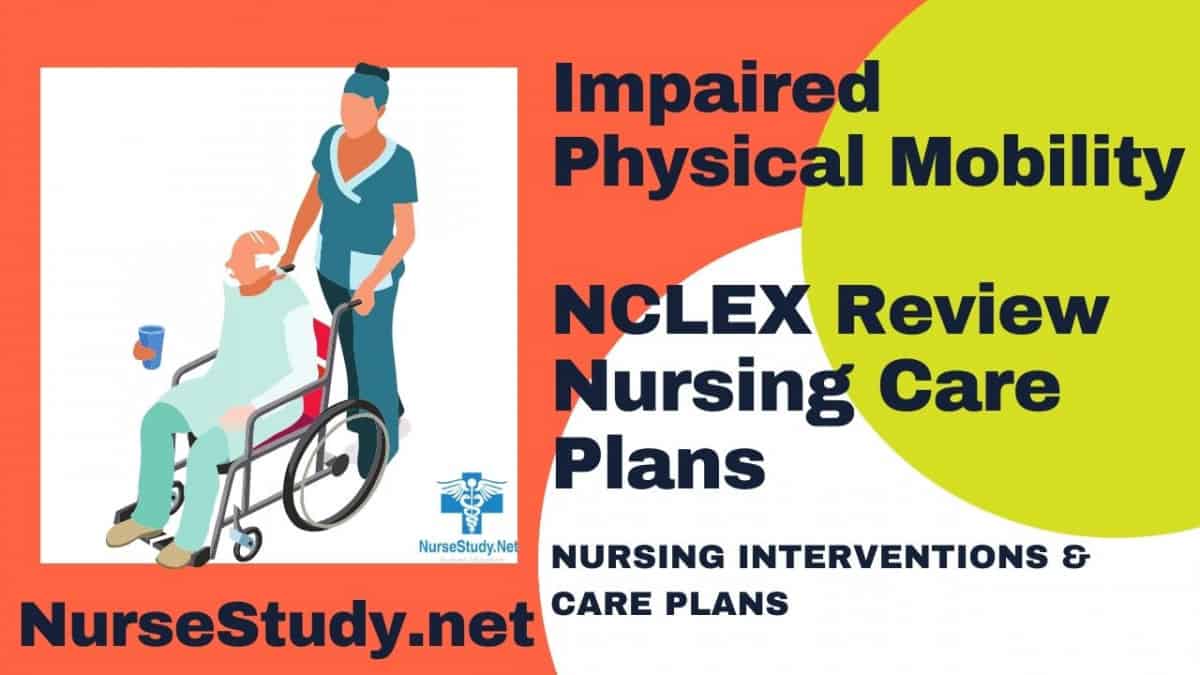
Impaired Physical Mobility Nursing Care Plans Diagnosis and Interventions
Mobility is simply defined as the ability to transfer or move from one place or another. This involves the use of one or more modes of transport such as walking, utilizing assistive devices, and/or vehicles.
Impaired Physical Mobility is a NANDA nursing diagnosis that can be used to create a care plan for patients who have realized mobility issues due to debilitating illness, injury, or post-operative status.
Cauda Equina Syndrome (CES)
Nursing Diagnosis: Impaired Physical Mobility related to vertebral and joint inflammation secondary to cauda equina syndrome as evidenced by severe leg pain rated 8 out of 10, leg muscle weakness, failure to perform ADLs, and verbalization of fatigue
Desired Outcome: Patient will maintain or regain functional mobility.
Multiple System Atrophy
Impaired physical mobility related to disease process of multiple system atrophy (MSA) as evidenced by bradykinesia, cognitive impairment, inability to bear weight, rigidity, generalized weakness, inability to do activities of daily living (ADLs) as normal, and verbalization of overwhelming tiredness
Desired Outcome: The patient will be able to perform activities of daily living within the limits of the disease.
Nursing Diagnosis: Impaired Physical Mobility related to Paget’s disease of the bone as evidenced by presence of stiffness, weakness and gradual loss of movement in the right leg, moderate bilateral leg pain rated 6/10, failure to perform ADLs
Desired Outcome: Patient will maintain functional mobility despite progressive Paget’s disease of the bone.
Psoriatic Arthritis
Nursing Diagnosis: Impaired Physical Mobility related to the clinical manifestations of psoriatic arthritis, as evidenced by distal interphalangeal predominant (DIPs) in the fingers, morning stiffness of wrists and elbows, pain score of 8 to 10 out of 10, fatigue, disinterest in ADLs due to pain, verbalization of tiredness and generalized weakness
Desired Outcome: The patient will demonstrate increase in functional physical mobility and successful performance of activities of daily living.
Hemiplegia
Nursing Diagnosis: Impaired physical mobility related to paralysis of one side of the body (hemiplegia) secondary to brain tumor as difficulty of movement, unsteady gait, generalized weakness, inability to do activities of daily living (ADLs) as normal, and verbalization of overwhelming tiredness/ fatigue
Desired Outcome: The patient will be able to perform activities of daily living within the limits of the present condition.
Congenital Hip Dysplasia
Nursing Diagnosis: Impaired Physical Mobility related to muscular dysfunction such as hip weakness secondary to congenital hip dysplasia as evidenced by movement limitation imposed by bandage, harness, cast, or traction and loss of the ability to move intentionally.
Desired Outcome: The patient will be able to rise in bed with the use of a tension bar, and walk the distance of the corridor and return twice a day.
Nursing Diagnosis: Impaired Physical Mobility related to dysfunction, pain, and discomfort in the musculoskeletal system secondary to scoliosis as evidenced by refusal to move freely and constrained range of motion.
Desired Outcome: The patient will learn to maintain good body posture and improve with physical activities as directed by the doctor.
Guillain-Barre Syndrome
Nursing Diagnosis: Impaired Physical Mobility related to neuromuscular dysfunction secondary to Guillain-Barre Syndrome as evidenced by ataxia and the inability to change movements purposefully within the physical environment, including bed mobility, relocation, and ambulation.
Desired Outcome: The patient’s endurance and performance of the affected limb will be improved, and he or she will illustrate the utilization of adaptive equipment to boost mobility.
Nursing Diagnosis: Impaired Physical Mobility related to joint pain and inflammation secondary to Kawasaki disease as evidenced by trouble in walking and constrained range of motion (ROM).
Desired Outcome: The patient will engage in activity on his or her own or within the limits of the health condition.
Amputation
Nursing Diagnosis: Impaired Physical Mobility related to the removal of a limb, particularly in the lower extremities, as well as physical discomfort, and sensory impairment, such as a distorted balance and stability secondary to amputation as evidenced by a hesitancy to move, loss of coordination, decreased muscular endurance, control, and mass.
Ackley, B. J., Ladwig, G. B., Makic, M. B., Martinez-Kratz, M. R., & Zanotti, M. (2020). Nursing diagnoses handbook: An evidence-based guide to planning care. St. Louis, MO: Elsevier. Buy on Amazon
Gulanick, M., & Myers, J. L. (2022). Nursing care plans: Diagnoses, interventions, & outcomes. St. Louis, MO: Elsevier. Buy on Amazon
Ignatavicius, D. D., Workman, M. L., Rebar, C. R., & Heimgartner, N. M. (2020). Medical-surgical nursing: Concepts for interprofessional collaborative care. St. Louis, MO: Elsevier. Buy on Amazon
Silvestri, L. A. (2020). Saunders comprehensive review for the NCLEX-RN examination. St. Louis, MO: Elsevier. Buy on Amazon
Please follow your facilities guidelines, policies, and procedures.
The medical information on this site is provided as an information resource only and is not to be used or relied on for any diagnostic or treatment purposes.
This information is intended to be nursing education and should not be used as a substitute for professional diagnosis and treatment.
Anna Curran. RN-BC, BSN, PHN, CMSRN I am a Critical Care ER nurse. I have been in this field for over 30 years. I also began teaching BSN and LVN students and found that by writing additional study guides helped their knowledge base, especially when it was time to take the NCLEX examinations.